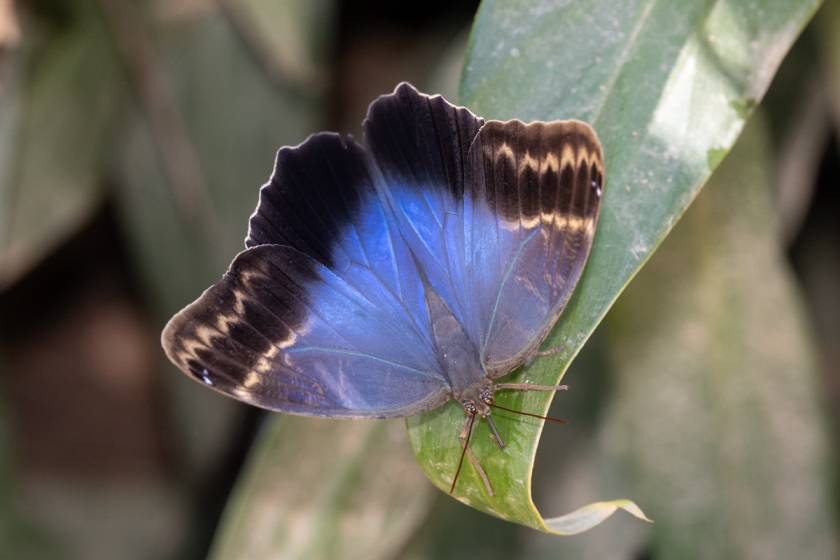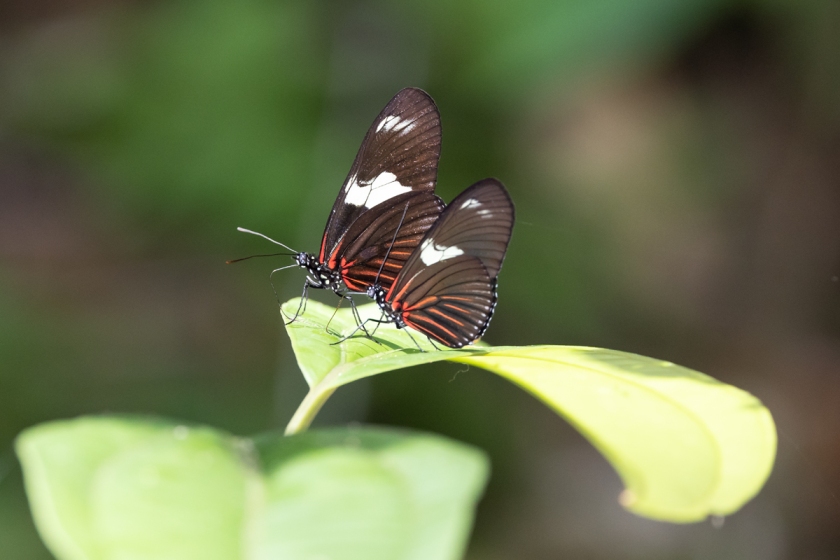On Day 11, I woke up at my usual time of 5 AM, got dressed and went out into the large garden of the lodge for some birdwatching. Once the sun came up, the first butterflies appeared and I bagged some six species even before breakfast.
Our destination for the day was the quarry of El Capricho where it was blazingly hot and very, very dry.

There were not many butterflies around, but the species that were present were pretty spectacular, such as Lyropteryx apollonia:

and Caligo illioneus oberon which even opened its wings for a definitive identification:


After an hour or so, we took the bus and moved a little higher up on the road, then went all the way to the top of the hill. After we had exhausted ourselves in the forest, we repeated the same sequence downhill.
Back at the quarry, I spotted Eunica eurota with its bright blue upperwings. It was very skittish and flew away every time I approached it just a little too much to its liking. I set the R6 to highspeed mode and hit the shutter button like a madman. It resulted in two things: 1) some acceptable shots of the flying Eunica and 2) a jammed R6. Luckily for me, switching it off and then turning it on worked and it functioned flawlessly afterwards.


Day 12 was our final full day of butterflying and would see us return to the Apuya trail. Again, the trail proved to be one of the most productive locations of the tour. Our second visit delivered 74 species, a personal day record. What is maybe even more astonishing is that the species count had only 28% overlap with our first visit to Apuya on 5 October, which yielded 71 species. This clearly shows the value of returning to the same location in the tour itinerary.
You may have read on this butterfly photography blog that I dislike walking single file through the rainforest, as usually only the front (wo)man sees the butterflies before they are scared off. So the start of our final day was not the best, but that would change soon.

Soon after, the group split: the majority went uphill with Andrew so I picked the valley track, known to us as “the gulley”. I never regretted the choice as I had the time of my life, photographing beautiful butterflies one after the other such as this magnificent Consul fabius:

One of the more spectacular discoveries was this female Thereus brocki. It was only described by science as recent as 2015 by Robbins, Heredia & Busby. I am grateful to Mr. Zsolt Bálint for the ID.

Another nice opportunity presented itself when two forms of Heliconius doris met on a single leaf. On the left is the common blue form, on the right the much rarer red form. To see both is nice, to see both on the same day is great and to have both in the same photograph is absolutely fantastic!


“The gulley” held no more surprises for me and I decided to switch places. While going uphill, I saw Andrew coming down and we greeted each other with what had become become our customary greeting:
“Ah, Dr. Neild, how nice to see you!” and the reply: “Hello Dr. Livingstone, how are you doing?”
We grinned like two schoolboys exchanging lame jokes, but who cared as long as we were having fun?
Having spent some time at the top of the hill, it was time to make my way downhill when I spotted something green and flashy. It turned out to be a female Paiwarria telemus:

While going downhill I met Andrew who was just coming uphill again, and of course I showed him my little green gem. This elicited a very audible “WHAT THE F…” from our otherwise polite and self-controlled Beloved Leader who “requested” me in a very instructive way, not unsimilar to how other Latin American dictators rule, to show me the exact spot where I had last seen this particular butterfly. We rushed to the scene, but Paiwarria telemus apparently had been warned and wisely gone underground to escape the unwanted attention of the Apuya secret butterfly police.
One last thing on the Apuya trail: since I published the blog on our first visit to the trail, many skippers have been identified. There is one in particular that warrants attention. Tosta pseudospeculum (or Eantis pseudospeculum) has only been described as recent as 2015 (Mielke & Casagrande). Mr. Bernard Hermier was very kind to identify my many skipper photographs and he congratulated with a “bravo” on finding this particular species. My gratitude goes out to Mr. Hermier for his kind help!

After these highlights, it was time for the drive to Rio Quijos Lodge where we enjoyed a fine meal of fresh trout. The rooms where large, quiet and dark so I slept like a baby.
Day 13, our very last day in the field, started with hummingbird watching with the sun still behind the horizon. The butterflying that day was difficult: we would depart around 14hrs so I felt a little rushed all day, butterfly numbers were not great so I had to cross the premises several times to find new species which consumed a lot of time and despite extensive baiting by Andrew, not much showed up.
The first pretty photograph was Eurema reticulata at the beach:

At the same beach, another highlight was this skipper pair. Dalla crithote on the left and Dalla mesoxantha on the right:

Somehow I had managed to get a very mild sunstroke so I felt a bit wobbly when I entered the bus. With windows open and the air getting chillier as we climbed, the symptoms quickly disappeared. After a brief stop at the Papallacta pass at 4,000 meters altitude, we descended towards Quito and checked in at the Holiday Inn. Part of the group left for the US straight after our farewell dinner, and the next morning it was just me and Andrew chatting away over breakfast while Emily & Brett were doing some birdwatching around the hotel. The most important bird to arrive later that day was the big blue KLM jet that brought me home.
To wrap it up: we had a phantastic tour thanks to Andrew and my fellow travellers. My grand total is 416 species plus some mysteries outstanding. With Panca steinhauseri, Tosta pseudospeculum and Thereus brocki the tour produced also three very nice rarities, as well as a rare sighting of Eurytides dolicaon. I am very pleased with the tour and would definitely like to recommend it to every butterfly lover. Needless to say, I already have sweet dreams about joining another tour somewhere in the future. Colombia, Peru maybe….zzzzzz….

